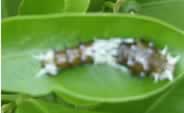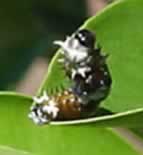Insect behaviour and survival
We have studied, our caterpillars show amazing behavioural patterns that
assist them in surviving their many predators. The many different behaviours
are permanently imprinted in the caterpillar’s brain. Although the
genes for flight are present in the caterpillar, you will not see the
caterpillar jumping from the branches of trees trying to fly. All these
behaviours come into play at crucial time during the insect’s development,
as a result of hormonal changes. Different hormones or different levels
of hormones turn certain behaviours on or off.
The Masters of Deception video is a very important resource for answering the questions below.
Answer the following question through careful observation.
1) During the brown and green stage, describe whereabouts on the tree does the caterpillar rest?
2) Describe how the caterpillar behaves when it rests on the tree
3) How does the caterpillar respond to being touched?
4) Describe the feeding pattern
- Does the caterpillar feed continuously?
- After feeding does the caterpillar return to
its original position on the tree?
5) Describe the behaviour of the caterpillar when
it is ready to attach itself to the tree.
6) Offer an explanation as to how each behaviour helps the insect survive.


